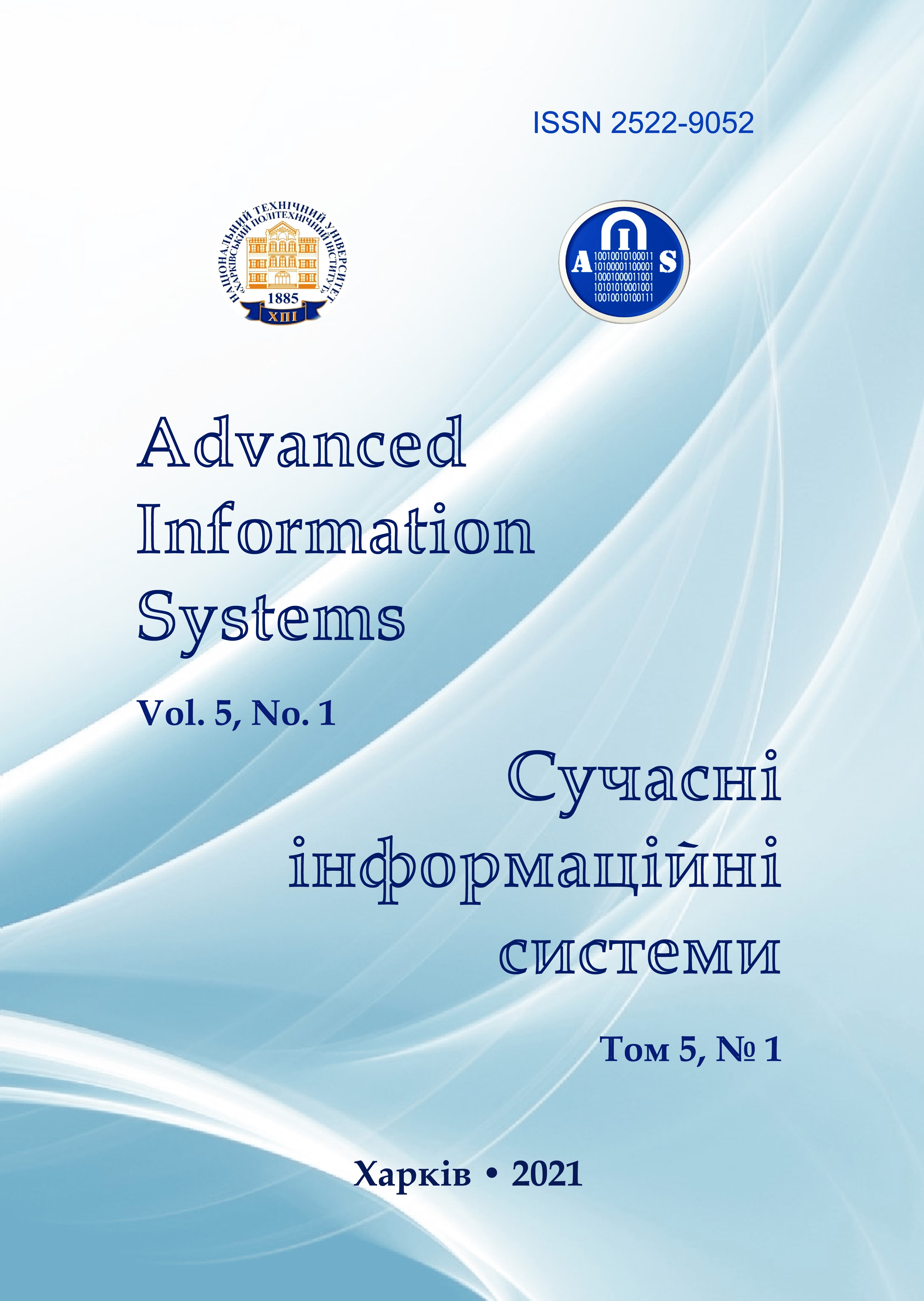Study of the effectiveness of image classifiers by statistical distributions for components of structural description
Main Article Content
Abstract
The subject of research is models for constructing image classifiers in the description space as a set of descriptors of key points in the recognition of visual objects in computer vision systems. The goal is to create and study the properties of the image classifier based on the construction of an ensemble of distributions for the components of the structural description using various models of classification decisions, which provides effective classification. Tasks: construction of classification models in the synthesized space of images of probability distributions, analysis of parameters influencing their efficiency, experimental evaluation of the effectiveness of classifiers by means of software modeling based on the results of processing the experimental image base. The applied methods are: ORB detector for formation of keypoint descriptors, data mining, mathematical statistics, means of determining relevance for sets of data vectors, software modeling. The obtained results: The developed method of classification confirms its efficiency and effectiveness for image classification. The effectiveness of the method can be enhanced by the introduction of a variety of types of metrics and measures of similarity between centers and descriptors, by the choice of method of forming centers for reference etalon descriptions, by the introduction of logical processing and compression of the structural description. The best results of the classification were shown by the model using the most important class by the distribution vector for each descriptor corresponding to the mode parameter. The use of a concentrated part of the description data makes it possible to improve its distinction from other descriptions. The use of the median as the center of description has an advantage over the mean. Conclusions. Scientific novelty is the development of an effective method of image classification based on the introduction of a system of probability distributions for data components, which contributes to in-depth analysis in the data space and increases in classification effectiveness. The classifier is implemented in the variants of comparing the integrated representation of distributions by classes and on the basis of mode analysis for the distributions of individual components. The practical importance of the work is the construction of classification models in the modified data space, confirmation of the efficiency of the proposed modifications of data analysis on examples of images, development of software models for implementation of the proposed classification methods in computer vision systems.
Article Details
References
Gorokhovatskyi, V.O. & Gadetska, S.V. (2020), Statistical processing and data mining in structural image classification methods, monograph, FLP Panov A.N., Kharkiv, 128 p., DOI: https://doi.org/10.30837 / 978-617-7859-69-6.
Duda, R.O., Hart, P.E. & Stork, D.G. (2000), Pattern classification, 2ed., Wiley, 738 p.
Flach, P. (2015), Machine learning. The science and art of building algorithms that extract knowledge from data, DMK Press, Moscow, 400 p.
Gorokhovatskyi, V.O., Pupchenko, D.V. & Solodchenko, K.G (2018), “Analysis of properties, characteristics and results of application of the newest detectors for definition of special points of the image”, Control, navigation and communication sys-tems, No.1 (47), pp. 93-98.
Tvoroshenko, I.S. & Gorokhovatskyi, V.O. (2019), “Intelligent Classification of Biophysical System States using Fuzzy Inter-val Logic”, Telecommunications and Radio Engineering, Vol. 78 (14), pp. 1303-1315, DOI:
https://doi.org/10.1615/TelecomRadEng.v78.i14.80.
Kim, S. & Kweon I.-S. (2006), “Biologically motivated perceptual feature: Generalized robust invariant feature”, Asian Conf. of Comp. Vision (ACCV-06), pp. 305-314.
Nong, Ye. (2013), Data Mining: Theories, Algorithms, and Examples, 1st. ed., CRC Press, Inc., USA.
Szeliski, R. (2010), Computer Vision: Algorithms and Applications, Springer, London, 979 p.
Svyrydov, A., Kuchuk, H. & Tsiapa, O. (2018), “Improving efficiency of image recognition process: Approach and case study”, Proceedings of 2018 IEEE 9th International Conference on Dependable Systems, Services and Technologies, DES-SERT 2018, pp. 593-597, DOI: http://dx.doi.org/10.1109/DESSERT.2018.8409201.
Porter, F.C. (2008), Testing Consistency of Two Histograms, ArXiv e-prints, pp. 1–35.
Gorokhovatskyi, V.O. & Ponomarenko, R.P. (2020), “Classification of images based on the formation of an independent sys-tem of clusters in the structural descriptions of the base of standards”, Advanced Information Systems, vol. 4, No. 2, pp. 17-23, DOI: https://doi.org/10.20998/2522-9052.2020.2.04.
Kohonen, T. (2001), Self-Organizing Maps, Springer-Verlag, Berlin, Heidelberg, DOI: https://doi.org/10:book/10.5555/558021.
Paklin, N.B. & Oreshkov, V.I. (2013), Business analytics: from data to knowledge, textbook, Peter, St. Petersburg, 704 p.
Gorokhovatskyi, V.A., Putyatin, E.P. & Stolyarov, V.S. (2017), “Study of the effectiveness of structural methods of image classification using a cluster data model”, Radioelectronics, informatics, management, No. 3 (42), pp. 78–85.
(2020), ORB feature detector and binary descriptor,
available at: https://scikit-image.org/docs/dev/auto_examples/features_detection/plot_orb.html.
Wang, J, Markert, K. & Everingham, M. (2009), “Learning Models for Object Recognition from Natural Language Descrip-tions”, Proceedings of the British Machine Vision Conference (BMVC-2009), London, UK, pp. 1-11.
Josiah, Wang, Katja, Markert and Mark, Everingham (2013), Learning Models for Object Recognition from Natural Language Descriptions, available at: http://www.josiahwang.com/projects/leedsbutterfly.
Gorokhovatskyi, V.O., Gadetska, S.V. & Ponomarenko, R.P. (2019), “Logical analysis and data processing for image classifi-cation based on the formation of a statistical description center”, Control, navigation and communication systems, No. 4(56), pp. 43–48, DOI: https://doi.org/10.26906/SUNZ.2019.4.043.
Celik, C. and Sakir, H. (2017), “Content based image retrieval with sparse representations and local feature descriptors: A com-parative study”, Pattern Recognition, Issue 68, pp. 1-13, DOI: https://doi.org/10.1016/j.patcog.2017.03.006.
Xu, Zhang, Felix, X. Yu, Svebor Karaman, & Shih-Fu. Chang (2017), “Learning Discriminative and Transformation Covariant Local Feature Detectors”, The IEEE Conference on Computer Vision and Pattern Recognition (CVPR), pp. 6818-6826.
Gorokhovatskyi, V.O, Gadetska, S.V., Styahlyk, N.I. & Vlasenko, N.V. (2020), “Classification of images based on an ensem-ble of statistical distributions by standard classes for structural description components”, Radio Electronics, Computer Science, Control, No. 4, pp. 85–94, DOI: https://doi.org/10.15588/1607-3274-2020-4-9.
